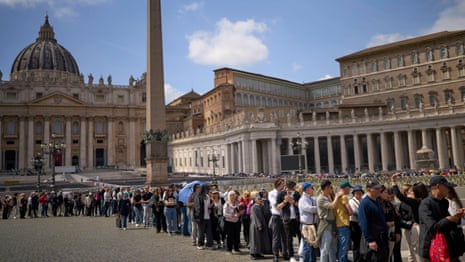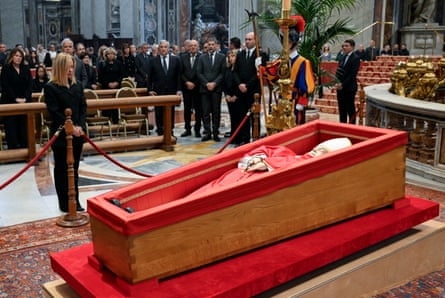Thousands of people queued for hours under the hot spring sun in St Peter’s Square on Wednesday to pay their final respects to Pope Francis, whose simple wooden coffin has been placed on the main altar of the 16th-century basilica, where he will lie in state until Friday evening.
The pope, the head of the world’s 1.4 billion Catholics, died at his home in Casa Santa Marta on Monday aged 88 after a stroke and subsequent heart failure. He had been recovering from double pneumonia, which had kept him in hospital for five weeks.
In keeping with his requests for simple funeral rites, Francis was dressed in his vestments, holding a rosary, with his open casket lined with red cloth.

Thousands pay respects as Pope Francis moved to St Peter’s to lie in state – video
Unlike those of most of his predecessors, his coffin, which is being watched over by two Swiss Guards, has not been raised on a platform. That was one of the rituals Francis shunned when he simplified rules for papal funerals last year.
His funeral mass will take place at St Peter’s Square on Saturday morning, an event that will be attended by a host of world leaders and royals, including the British prime minister, Keir Starmer, the US president, Donald Trump, and Prince William. He will then be buried at the Santa Maria Maggiore Basilica in Rome’s Esquilino neighbourhood, breaking with longstanding Vatican tradition.

The Italian prime minister, Giorgia Meloni, paying her respects to Pope Francis inside St Peter’s Basilica. Photograph: Vatican Media Handout/EPA
On Wednesday morning, mourners erupted into a prolonged but sombre applause as Francis’s coffin was carried through the square by pallbearers in a solemn procession involving dozens of cardinals and bishops, and watched over by Swiss Guards.
The bells of the basilica gently tolled as a choir chanted psalms and prayers in Latin, repeating the call to “pray for us”.
“It was the most profound moment,” said Cardinal Thomas Christopher Collins, the former archbishop of Toronto, who was among the procession. “But from the simple prayers to the incense, it was no different to a [funeral] ritual that any baptised person would have.”
As of Wednesday night, a Vatican official said almost 20,000 people, from all parts of the world, had joined the queue, which stretched along the road leading to Vatican City, to pay their respects to Francis, many holding umbrellas to shield themselves from the sun.
Braced for a long wait, Abigail and her family, from California, brought food. “We’re happy to wait as long as it takes,” she said. “It’s a privilege to be here.”

The queue of people outside the basilica waiting to pay respects to the pope. Photograph: Cecilia Fabiano/LaPresse/Rex/Shutterstock
It was only a few days ago that Francis had made his way through St Peter’s Square aboard the popemobile before appearing on the basilica’s central balcony to give a blessing to the crowds gathered for Easter Sunday mass. It was his final public appearance.
Even though people were aware that Francis was seriously ill, some of those waiting in the queue to pay tribute were still struggling to digest the fact of his death.
“It feels strange that he is no longer with us,” said Piotr Grzeszyk, from Poland.
Their shoulders wrapped with the flag of Francis’s native Argentina, Vicky Cabral and her family arrived in Rome from Buenos Aires on Saturday and saw Francis on the balcony the next day.
They had been hoping to get another glimpse of him during the now suspended canonisation of Carlo Acutis, which had been due to take place on 27 April.
“We came to Italy for the Catholic jubilee year and for Carlo Acutis,” said Cabral. “But it now feels like a real blessing to be here for this special moment. Francis was a great pope and I think he should be made a saint too.”
Once through the huge bronze doors and inside the cavernous basilica, pilgrims fell silent as they shuffled slowly towards the altar.

The body of Pope Francis is taken into St Peter’s Basilica. Photograph: Stefano Spaziani/UPI/Rex/Shutterstock
Francesco Catini, who travelled to Rome from Venice, had waited for four hours to see Francis’s body. “It was a beautiful experience,” he said. “To me, Francis was a living example of peace, of love, and especially of humility and solidarity.”
Chiara Frassine, from Brescia in northern Italy, had waited a similar amount of time. “I’m very happy to be here,” she said as she left the basilica. “Pope Francis had a pure soul. He was a humble point of reference for many people, not just Catholics.”
Not everyone waiting to pay their respects was Catholic. Standing at the end of the queue was Gunnar Prieß, from Germany, who arrived in the Italian capital on Wednesday morning.
“I booked a flight only to be here to see this,” he said. “I am not Catholic, but this is so majestic. What we’re seeing here today is the expression of a holy ritual that goes back 2,000 years. There’s an aura in the Vatican and I wanted to experience it.”

Crowds in St Peter’s Square as the pope’s coffin was taken into the basilica. Photograph: Cecilia Fabiano/LaPresse/Rex/Shutterstock
As the funeral rituals continue, speculation is rife about who will succeed Francis. Some 103 cardinals met on Wednesday evening and approved nine days of mourning from the date of the funeral, with a conclave – the secret election process to choose a new pope – therefore not expected to begin before 5 May.
There is no clear frontrunner, although Luis Antonio Tagle, a reformer from the Philippines, and Pietro Parolin, from Italy, who were among the procession, are early favourites.
Collins will be involved in the conclave too and, at 78, will be among the 135 cardinals eligible to vote. But he declined to give any hint of who he thought might succeed Francis.
